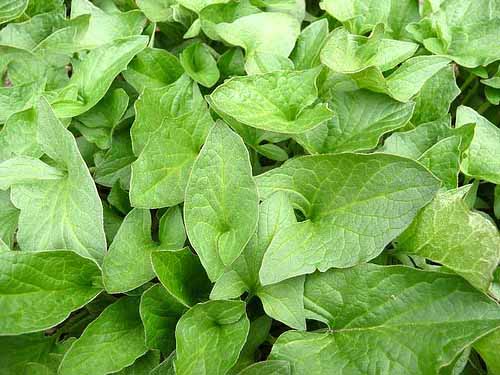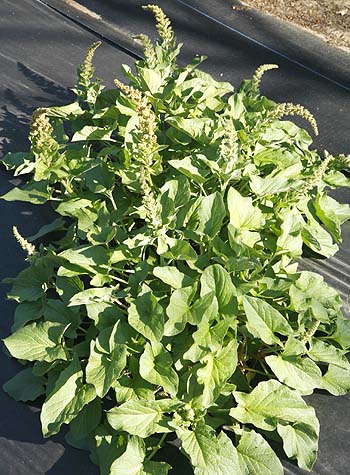For those who love to enjoy fresh spring greens this plant is perfect for you. Good King Henry is kind of like spinach but it's a perennial and it also likes shade! Not only that but the first shoots can be eaten like asparagus, leave them to form leaves and you have greens. What more could you ask for? Good King Henry is rich in iron, calcium, vitamin B, and vitamin C and many claim it provides more nutrition than spinach. The lush leaves make an attractive luxurious plant as well as a food and it makes a good ground cover. Once established it takes little care provided it has sufficient water. The Luscious leaves are of course just as attractive to animals as to us so protect from deer and rabbits. Pick your spot well as it does not like to be transplanted. The flowers stalks nothing to get excited about and can be pinched off to encourage more leaf growth. The delicious leaves start growing very early in the springtime so its one of the first greens available. Pick leaves and more appear, just don't pick them all and kill the plant.
Some sources claim that this seed is hard to germinate. It certainly does better if it has been stratified first all our seed has been cold-stratified.
Start seeds in plug cells, or small pots in mid to late winter in good potting soil and keep moist until seeds germinate. As stated germination can be slow so some plants may germinate rapidly others can take up to 180 days so be patient and don't throw out the pots too soon.
Once seedlings have germinated transplant to small pots (if not already sown in them) and grow on to small plants. Harden off outside. Wait until roots can be seen just growing from the bottom of the pot before transplanting. This ensures that as little root disturbance as possible will take place when planting. Tap pot and try to remove soil whole and just place in the ground. This plant does not like to be transplanted so as little change as possible is required.
Location and care of Good King Henry (Chenopodium bonus-henrius).
For best results this plant needs good rich soil with a lot of organic material to produce the lush green leaves. However will grow in most soil types and needs little care once established. Likes to have a moist soil that is well drained, cannot tolerate water logged soils
Prefers a semi shaded location, dappled shade under trees or at least shade from noon day sun is essential. Ideal for semi shaded areas where lush leaves bring an exotic look to the garden.
Water daily for the first year at least. A soaker hose is ideal providing a small amount of water without overuse. When there is no rain ensure that plants are watered daily during rainy periods water should not be needed. Little other care is needed and thrives well on neglect as long as it has enough water.
Be sure to pick your desired location as this plant does not take well to transplantation without considerable care.
Space plants 12-18" apart and rows at least 24" or more. Being a perennial it will produce a good crop of leaves for many years.
Allow plants to establish themselves during the first year, they wont produce much at this time and they need to settle in. Begin harvesting the leaves early spring of the second year. Zone 3-9
In early spring allow the first few leaves to develop to ensure that the plant can survive well. Shoots can be gathered, pealed and used like asparagus. After June leave the shoots to develop, eat the succulent young leaves and flowering stems in salads or cooked like spinach. The flowers can be sautéed in butter. Seed can be ground and mixed with flour then used in making bread.
Pick and use straight away, it doesn't store well in the fridge, but can be stored in the freezer.
Chickens especially seem to have a special fondness for Good King Henry; one of its common names is "fat hen". The root is used as a cough remedy for livestock such as sheep and goats.







-flower.jpg)

leaves.jpg)